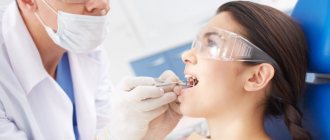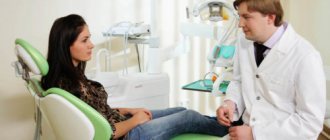Every resident of our country is familiar with these problems first-hand - the prevalence of dental pathology in two-year-old children is already close to 30%, by adolescence it reaches 98%, and in adulthood only a few have an absolutely healthy oral cavity.
These figures are all the more depressing because most diseases can be successfully prevented: modern dental science and practice know the causes and conditions of their occurrence and development, and are armed with effective methods of primary and secondary prevention.
As with most diseases, most of the risk factors for the development of dental caries, periodontal pathology and occlusion pathology are determined by people's behavior. Therefore, an important part of the preventive strategy is informing the population about the nature of diseases, teaching simple and effective methods of preventive self-help, and motivating them to develop healthy habits in the family.
Dental caries is the most common chronic infectious disease in children and adults. The disease is caused by opportunistic microorganisms (streptococci and lactobacilli) that live in dental plaque.
The named microorganisms are normal participants in the oral biocenosis and do not cause harm to a healthy system. Every time after a meal containing carbohydrates, acidogenic microbes process food debris retained in the periodontal environment, obtaining energy through the process of glycolysis and releasing lactic, acetic and other organic acids. Acids cause partial dissolution of surface crystals of tooth enamel, consisting of calcium and phosphorus compounds - demineralization of enamel.
However, under normal conditions, demineralization is quickly replaced by remineralization: saliva, which is a supersaturated solution of the mineral components of enamel, restores tooth tissue.
Conditions predisposing to the development of caries:
- high aggressiveness of cariogenic dental plaque: determined by the properties of the strains and the number of acidogenic microorganisms in dental plaque (their numbers increase in an environment rich in carbohydrates);
- low level of enamel mineralization: determined by genetics, conditions for the formation of dental tissues (i.e., the health of both the expectant mother and the child, up to adolescence) and, in addition, is characteristic of all teeth in the first years after eruption;
- small quantity, high viscosity, low mineralization of saliva, low immune potential.
The modern model of etiotropic and pathogenetic prevention of dental caries consists of several key recommendations.
Prevention of early colonization of a child’s teeth by cariogenic microflora. The source of microorganisms is the saliva of people close to the child. It is necessary to reduce the number of cariogenic microflora of the mother (this is helped by sanitation of the oral cavity, the use of chewing gum with xylitol, rinses with antiseptics, a good level of oral hygiene) and to exclude salivary contact with the child (do not lick the pacifier, do not try the child’s food with his spoon, etc. .).
Balanced diet. To avoid encouraging the growth of cariogenic microflora, dental exposure to carbohydrates should be minimized. It is important to avoid frequent carbohydrate snacking and drinking. Teeth-safe snacks include cheese, nuts, and meat products; It is better to quench your thirst with water.
Oral hygiene. It is necessary to remove microbial plaque from all surfaces of all teeth at least twice a day. It is important to ensure mechanical removal of complex, sticky plaque with a brush and threads (floss).
The use of fluorides, calcium, phosphates. In order to prevent the dissolution of enamel and help its restoration, the periodontal environment should be enriched with macro- and microelements. An important role is played by the consumption of fluoride-containing table salt (iodized-fluorinated salt), as this ensures an increase in the concentration of fluoride in saliva. Another important source of fluoride and calcium are preventive toothpastes.
Oral hygiene
The main cause of most oral diseases is the active proliferation of pathogenic microorganisms. We can conclude that the main preventive measure in dentistry is regular and high-quality oral hygiene. Let's look at the important rules:
|
Eating habits
The condition of our teeth largely depends on what we eat. It is recommended to minimize the intake of fast carbohydrates (various sweets, flour, carbonated sweet water, etc.). It is necessary to saturate the diet with fermented milk products, fresh fruits and vegetables. It is important that the body does not experience a deficiency of vitamins or microelements.
Important! Food that is too cold or hot is extremely harmful to teeth; this can lead to increased sensitivity of the enamel.
BIBLIOGRAPHICAL LIST
Ch. editor - S.E. Shorin (e-mail: [email protected] ) Technical editing and layout - VA. Sysykina
License LR No. 065167 dated May 12, 1997. Signed for publication on January 16, 2001. Format 60x88 1/16 Offset paper No. 1. Typeface Petersbyrg. Offset printing. Pech. l. 21.75. Circulation 2000 copies. Order 4146 I.G. “Medical Book” 101000, Moscow, PO Box 68 Publishing House NGMD 603002. Nizhny Novgorod, st. Chkalova, 6 Printed at the VINITI Production and Publishing Plant, 140010, Lyubertsy, Moscow region. Oktyabrsky Prospekt, 403. Tel.: 554-21-8G
Preventive dental procedures
At your dentist’s appointment, you can perform several preventive procedures that will protect your teeth from various diseases:
|
CHAPTER 14. MAIN DIRECTIONS FOR PREVENTION OF DENTAL ANOMALIES AND DEFORMATIONS
14.1. Prevention of dental anomalies during fetal development
14.2. Prevention of dental anomalies associated with artificial feeding
14.3. Prevention of dental anomalies and deformations associated with bad habits
14.4. Prevention of dental anomalies and deformations associated with impaired nasal breathing
14.5. Prevention of eumaxillary anomalies and deformations associated with the destruction and absence of teeth
14.6. Hygienic education during orthodontic treatment
Recommendations from experts
The most important preventative measure is regular visits to the dentist.
. Experts strongly recommend dental examinations at least twice a year. This will allow timely detection of possible pathological processes, such as caries and other dental diseases. In the early stages, they can be easily stopped without the likelihood of relapse and complications.
Important! You should immediately visit a dentist if you experience enamel sensitivity, bleeding gums, toothache or discomfort while eating. These symptoms may indicate developing pathological processes.
Compliance with the above measures guarantees the preservation of oral health for many years.
Dental prevention in children
Healthy teeth are an integral part of a child’s carefree childhood. Proper care, absence of caries and other diseases guarantees oral health. Therefore, it is necessary to carry out timely dental prophylaxis in children.
What can happen to children's teeth?
Children can be classified as a special group of patients. In pediatric dentistry they are always at risk. After all, their body is just learning to work. All protective mechanisms are not yet perfect, and the immune system reacts quite violently to aggressive external influences.
The following factors will contribute to the even greater development of caries, as well as its spread and complications: thin enamel, imperfect immunity, only partial mineralization of teeth, and the anatomical and physiological characteristics of the child.
Caries is one of the sources of chronic infections. It can be the cause of many somatic pathologies. Such as diseases of the gastrointestinal tract, kidney diseases, etc. And caries can also cause complications and even threaten the health of children, not to mention various malocclusion pathologies.
Malocclusion can cause children to become isolated in society, withdrawn, and perform poorly at school. Everything in our body is certainly interconnected. Therefore, it is important to start oral hygiene in children on time and visit the dentist on time.
Caries and malocclusion are some of the consequences of poor dental care
It is possible to prevent caries in a child already during pregnancy and breastfeeding.
At the planning stage of pregnancy, a woman needs to ensure that her body is filled with the necessary vitamins and microelements for the full development of the child. Carry out a complete sanitation of the oral cavity, because caries is a breeding ground for infections, and the formation of organs, including teeth, occurs already in the seventh week of pregnancy. And already at the end of the first half, the baby’s teeth begin to materialize.
Doctors also recommend taking tablets that contain only 1 mg of fluoride. This allows you to achieve two effects at once: the fetus develops strong teeth, and the woman does not wash out fluoride from the body, which ensures that health is maintained at the proper level. Also, do not forget about calcium, which both the unborn child and the mother herself need.
Another important factor in the formation of healthy teeth in a baby is the mother’s regular visits to the dental office. The child takes all the missing “building materials” for his body from the woman’s reserves. And this, in turn, can lead to a lack of vitamins and microelements, and therefore can cause caries, its complications and other diseases of the oral cavity.
A balanced diet will help stop the occurrence of caries and other diseases.
When preventing caries of primary teeth in children, it is important to provide adequate nutrition. Your child's diet should include calcium from dairy products. For better absorption of calcium, vitamin D is also necessary, which can be obtained from fish or exposure to sunlight. Therefore, take your child for walks in the fresh air more often - this helps strengthen the child’s teeth and immunity.
As your child grows, adjust his diet. Dentists recommend excluding some dishes altogether, while adding others, on the contrary. Here are some foods that are considered harmful not only to a child’s teeth, but also to an adult’s:
- Any chocolate products;
- sweets, pastries and cakes;
- fruits with high acidity;
- sweet carbonated drinks;
- concentrated juices, as well as homemade compote, due to their high sugar content.
These products also harm the gastrointestinal tract, causing an imbalance in the acid-base balance. But they can be replaced with more useful ones to avoid dental problems:
- Green tea. It contains natural antioxidants, which slows down the process of caries formation;
- lime. Even though it's citrus. It is rich in fluoride and calcium;
- carrot. This vegetable is rich in vitamins, and its dense structure allows you to cleanse your teeth of plaque.
Dentists also have their own opinion about snacks between main meals. They carry a fairly large factor in the development of caries in children, because they do not allow the acid balance to be restored. Therefore, give preference to solid foods such as apples, carrots, and pears. They do the best job of removing plaque that forms on teeth throughout the day.
It is necessary to practice oral hygiene when a child’s first tooth appears.
It is advisable for the baby to wipe his teeth with a soft cloth or gauze after eating and before going to bed in the direction: from the edge of the gums to the surface of the teeth. As the child gets used to this procedure, a toothbrush with soft bristles and a small head should be used. To prevent baby teeth, it is also recommended to use special wipes with xylitol, which provide protection against microbes.
Dentists also recommend using toothpastes containing fluoride. Such pastes are especially necessary for children with an increased risk of caries. Until the age of 12, parents must supervise the cleaning process. You should not allow your child to swallow fluoride toothpaste. As your baby gets older, you can choose toothpaste with a higher concentration of fluoride.
Always pay attention to the composition of the toothpaste, its quality and purpose. Give preference to those that contain calcium, fluorine, phosphorus to strengthen the enamel, and also correspond to the child’s age.
The next step on the path to healthy teeth is brushing.
It is very important to instill in your child the habit of brushing their teeth every day. This way he realizes the importance of hygiene much earlier. And he will learn to take responsibility for his dental health.
To make the brushing process enjoyable, you need to choose the right toothbrush. At a young age, it is better to give preference to soft bristles so as not to damage the delicate mucous membrane of the gums. They are usually sold in stores labeled “soft”. As you get older, you can switch to medium-hard toothbrushes. They will provide a more thorough cleaning of plaque. Brushes are labeled “medium”.
Only with the help of toothpaste and a brush can you achieve almost complete cleansing of stuck food and plaque. But there is one more important point! Brushes need to be changed promptly, approximately once every three months. With prolonged use, bacteria remain and multiply on the bristles, making the cleaning process less effective.
Take your child to the dental office at least three times a year.
Prevention in pediatric dentistry is not complete without an experienced specialist. Therefore, make it a rule to see a dentist. Only through a professional examination can the development of caries and other oral diseases be detected and prevented in the early stages. If your child does develop early caries, he will promptly carry out all the necessary tests and prescribe treatment. Most often, the following procedures are recommended for children.
- Fluoridation
The doctor coats the child’s teeth with a special innovative composition. It saturates the enamel with all the necessary microelements. Thanks to this procedure, the teeth will become more resistant to aggressive external influences.
- Fissure sealing
This method of treatment and prevention is done both for preschool children with baby teeth and for teenagers. It is advisable to do this procedure within a month or a month and a half from the moment the first molars appear. The doctor closes the deep grooves on the chewing surface of the tooth. Thus, it is possible to eliminate the accumulation of pathogenic bacteria in hard-to-reach places. To do this, experts use fluoropolymer sealant that is resistant to saliva, liquids and acids.
Fissure sealing is one of the necessary methods of prevention
At the first stage, the dentist thoroughly cleans the teeth using a professional brush and toothpaste. Then he applies an acidic substance to the grooves of the pits that have formed on the surface of the tooth. After this, a sealant is applied to the tooth, which is distributed by flowing into the micropores of the enamel and hardens firmly under the influence of a special lamp. This sealant not only “seals” the tooth, but also saturates its enamel with magnesium, calcium and fluoride.
As a result of this procedure, after eating, plaque and bacteria will not accumulate on the chewing surface, which destroy the child’s healthy enamel.
Pharmacy medications will also help improve dental health.
Our diet does not always have enough necessary substances and minerals. Therefore, in pediatric dentistry, doctors recommend receiving all the necessary vitamins in concentrated and dosed form. Today on the shelves of pharmacies you can find many different mineral complexes and vitamins. They are divided into different categories: according to composition, age, indication for use, etc.
To maintain dental health, dentists recommend choosing vitamins with high concentrations of calcium, phosphorus and fluorides. Be sure to consult your doctor before purchasing and using any vitamin complex.
Proper brushing techniques will help keep your teeth healthy.
Brushing teeth for children is not much different from for adults. When cleaning the inner and outer surfaces of teeth, the brush should be positioned at an angle of 45 degrees to the tooth. Perform sweeping movements from the gum to the edge of the tooth. This will thoroughly clean the oral cavity of food debris and plaque. Then, when brushing the chewing surface, position the toothbrush horizontally and move it in a circular motion across the entire dentition, top and bottom.
If you are still not sure how to brush your teeth properly, watch instructional videos. This will make the task much easier.
Brushing children's baby teeth for 2-3 minutes is sufficient. However, this is the norm for an adult. So please be patient while cleaning. If it is difficult for your child to withstand such a procedure, try to turn cleaning into a game, because simple persuasion, as practice shows, does not always help.
Already during the first brushing of teeth, tell your child how useful this procedure is for him. If the child’s fear and reluctance do not go away, then you can watch special educational and preventive pictures that are specially created for children. The sooner you start brushing your teeth with your child, the sooner he will begin to do it on his own. And even more quickly brushing teeth will become a daily habit.
Don’t forget about general hygiene procedures.
High-quality cleaning of the tooth surface and interdental space is unthinkable without additional hygiene, which you need to know about. To do this you need:
- After every meal, rinse your mouth. It is advisable to use special antiseptic solutions for this, which can be found in any pharmacy, or products containing useful microelements. But if for some reason it is not possible to use such products, then ordinary water will do;
- use floss and dental floss. They help clean the spaces between teeth more thoroughly. Such threads are round and flat. It is advisable for children to choose flat flosses in order to avoid wounds on the gums. It is necessary to floss in the presence of an adult, otherwise the child may harm his teeth;
- buy an irrigator. This device is designed for high-quality teeth cleaning at a professional level. Doctors use this not only in pediatric dentistry, but also in adult dentistry. But you can also use it at home if you familiarize yourself with its effects in advance. Here is the main purpose of the irrigator:
- It provides the most effective oral hygiene at home;
- helps prevent the development of other diseases such as periodontitis and gingivitis;
- Suitable for cleaning not only the surface of teeth, but also various artificial structures. It is especially recommended to use this cleaning method when your child has braces or platins;
- prevents the active proliferation of bacteria, and as a result stops carious formations;
- increases blood microcirculation in the gums. The principle of operation of the irrigator is similar to therapeutic massage;
- has a positive effect on the proper functioning of the salivary glands, which again has a beneficial effect on the condition and health of the oral cavity.
Remember that the best treatment in childhood is prevention.








